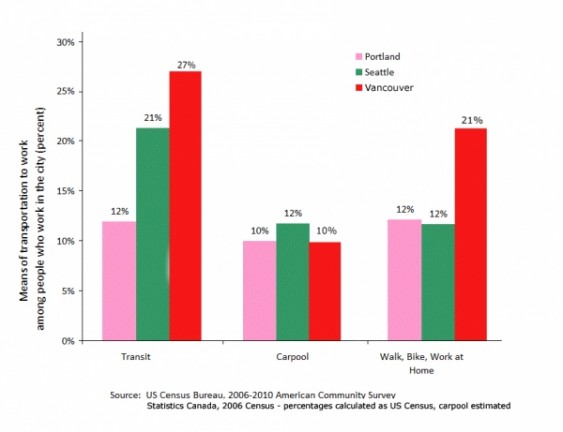Editor’s note: This post was originally posted on Price Tags.
Inspired by Sightline’s post on commuting in Seattle and Portland, development blogger and numbers guy Andy Coupland went to work in the StatCan data mines to see how Vancouver stacks up against its neighbors to the south. Here are his results, with an important qualification at the bottom.
Means of transportation among people* who work in the city:
Transit commuting rates for in-city workers:
Share of workers within city limits who take transit to work, by men and women:
Transit commuting rates for in-city workers, by annual income:
* These are workers – not residents (although many of the workers in the city are residents) and they’re using as close to possible US definitions – not Canadian (so work at home is a travel mode, for example). Note that they aren’t exactly the same as I can’t make Canadian and US data fit exactly. The caveats at the bottom are important to note. The data are from the Statistics Canada website .
Editor’s note: Andy passed on a few caveats:
To match the mode on the first graph I added in work at home, and took the number shown as ‘passenger’ and doubled them to get carpool. Carpool could be a bit lower as obviously some will be multiple riders – but there’s really no way of getting at that from Canadian data.
On the age graph, the first category is 15-25, not 20-25, so the propensity to take transit to work is probably higher (although there are almost certainly a higher proportion aged 20-24 than 15-19 in the 15-24 workers group). Note that the Canada Line transit wasn’t in operation in 2006, so the more recent data likely will/would show a higher transit %.
As far as I know gender is defined in the same way on both sides of the border!
I didn’t try to translate US and Canadian dollars. The breakpoints aren’t the same – Canada uses $10K increments to $60K, then $60 – $80K and over $80K. The line is therefore not completely comparable to the US examples, but the slope is probably a pretty good representation of the trend – and here it’s absolutely about the income!










